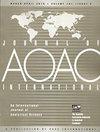Development of Two Eco-Friendly and High-Throughput Microwell Spectrophotometric Methods for Analysis of an Antibacterial Drug Tulathromycin in Pharmaceutical Bulk Form.
IF 1.7
4区 农林科学
Q3 CHEMISTRY, ANALYTICAL
引用次数: 0
Abstract
BACKGROUND Tulathromycin (TUL) is a triamilide antibacterial drug which has been approved for use in the European Union and the United States for the treatment and prevention of bovine respiratory diseases. The existing methods for determination of TUL in its pharmaceutical bulk form are very limited and suffer from major drawbacks. OBJECTIVES The aim of this study was the development of two innovative microwell spectrophotometric methods (MW-SPMs) for determination of TUL in its pharmaceutical bulk form. METHODS The formation of charge transfer complexes (CTCs) of TUL, as an electron donor, was investigated with 2,5-dihydroxy-3,6-dichlorocyclohexa-2,5-diene-1,4-dione (HCD) and 2,3-dichloro-5,6-dicyano-p-benzoquinone (CBQ), as π-electron acceptors. The CTCs were characterized by using UV-visible spectrophotometry and computational calculations. The reactions were employed for the development of two MW-SPMs with a one-step for the quantitative analysis of TUL. RESULTS The formation of CTCs was confirmed via the formation of characteristic absorption bands with maximum absorption at 520 and 460 nm for CTCs with HCD and CBQ, respectively. The stoichiometry of both CTCs was found to be 1:1, and the values of different spectroscopic and electronic constants confirmed the stability of the CTCs. The mechanisms of the reactions were postulated. The linear range of both MW-SPMs was 10-500 µg/mL. The limits of quantitation were 13.5 and 26.4 µg/mL for methods involving reactions with HCD and CBQ, respectively. Both methods were successfully applied to the quantitation of TUL in pharmaceutical bulk form with acceptable accuracy and precision. The results of eco-friendliness/greenness assessment proved that both MW-SPMs fulfill the requirements of green analytical approaches. In addition, the one-step reactions and simultaneous handling of a large number of samples with micro-volumes in the proposed methods gave them the advantage of high throughput analysis. CONCLUSIONS This study described two new MW-SPMs as valuable analytical tools for the determination of TUL.开发两种环保型高通量微孔分光光度法,用于分析散装抗菌药图拉霉素
背景图拉霉素(TUL)是一种三酰氨基苯胺类抗菌药,已被欧盟和美国批准用于治疗和预防牛呼吸道疾病。本研究旨在开发两种创新的微孔分光光度法(MW-SPMs),用于测定药用散装 TUL。方法以 2,5-二羟基-3,6-二氯环己-2,5-二烯-1,4-二酮(HCD)和 2,3-二氯-5,6-二氰基对苯醌(CBQ)为π电子受体,研究了作为电子供体的 TUL 的电荷转移复合物(CTC)的形成。利用紫外-可见分光光度法和计算对四氯化碳进行了表征。结果四氯化碳的形成是通过与 HCD 和 CBQ 的四氯化碳分别在 520 nm 和 460 nm 处形成最大吸收的特征吸收带来证实的。两种四氯化碳的化学计量比均为 1:1,不同光谱常数和电子常数的值证实了四氯化碳的稳定性。推测了反应的机理。两种 MW-SPM 的线性范围均为 10-500 µg/mL。涉及与 HCD 和 CBQ 反应的方法的定量限分别为 13.5 和 26.4 微克/毫升。这两种方法都成功地应用于散装药物中 TUL 的定量分析,准确度和精密度均可接受。生态友好/绿色评估结果证明,这两种 MW-SPM 均符合绿色分析方法的要求。此外,这些方法一步反应,同时处理大量微量样品,具有高通量分析的优势。
本文章由计算机程序翻译,如有差异,请以英文原文为准。
求助全文
约1分钟内获得全文
求助全文
来源期刊

Journal of AOAC International
医学-分析化学
CiteScore
3.10
自引率
12.50%
发文量
144
审稿时长
2.7 months
期刊介绍:
The Journal of AOAC INTERNATIONAL publishes the latest in basic and applied research in analytical sciences related to foods, drugs, agriculture, the environment, and more. The Journal is the method researchers'' forum for exchanging information and keeping informed of new technology and techniques pertinent to regulatory agencies and regulated industries.
 求助内容:
求助内容: 应助结果提醒方式:
应助结果提醒方式:


